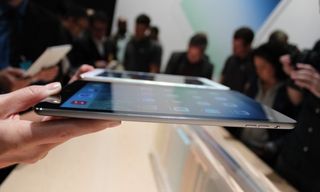iPad Air (5th Gen) vs. iPad 4: Is It Worth the Upgrade?

If you’re one of the many iPad owners that rushed out to purchase an iPad 4 last holiday season, congratulations. Your iPad is now obsolete. Apple has upgraded its iPad to include some of the coveted featured found in its other mobile products, including a sleeker design that’s reminiscent of the iPad Mini and the new A7 processing power that debuted in the iPhone 5s.
Apple claims that it has sold 170 million tablets to date, accounting for 81 percent of the tablet market. But will the $499 iPad Air keep Apple at the forefront of the competition? Only time will tell, but here’s a quick look at how the iPad Air stacks up against the fourth generation slate for those considering the upgrade.
MORE: iPad Air Hands-on: Amazingly Light Design Redefines 'Big' Tablets
Design
Apple is touting the iPad Air’s hardware as its main selling point, boasting that it’s 20 percent thinner than its predecessor. The bezel alone has slimmed down by 43 percent, according to Apple CEO Tim Cook, who revealed that the new tablet measures at just 7.5mm thin. Flaunted as the lightest 10-inch tablet in the world, the 1-pound iPad Air is just slightly lighter than the 1.4-pound iPad 4.
Not only is the iPad Air thinner and lighter than its predecessor, but it borrows some design cues from its smaller iPad Mini sibling. Apple newest full-size iPad essentially looks like a larger iPad Mini, complete with its rounded edges and slimmer side bezels.
Performance
Apple has made some significant under-the-hood changes, too. The iPad Air comes with the A7 64-bit processor that was introduced with the iPhone 5s, which we praised for its snappy performance during our review. During our brief hands-on with the iPad Air, we were pleased to see the same speedy response when it came to launching apps.
But 64-bit processing means that the iPad Air can handle more than just surfing the Web and running apps. The iPad Air and iPhone 5s’ 64-bit processing essentially means that it can crunch numbers faster and more efficiently, enabling it to encode and decode video faster in particular.
Stay in the know with Laptop Mag
Get our in-depth reviews, helpful tips, great deals, and the biggest news stories delivered to your inbox.
We haven’t benchmarked the A7 chip inside the iPad Air just yet, but the iPhone 5s’ A7 processor scored a roaring 2,556 on Geekbench 3, blazing past the 1,447 category average for tablets and 1,552 category average for smartphones. The iPad 4’s quad-core A6x chip scored 1,426 during the same test.
MORE: iPad Mini Retina Display Hands-on: High Resolution, High $399 Price
Should You Upgrade?
If you’re in the market for a new iPad, the iPad Air is just about as much of a change as you could hope for. With a thinner, lighter design, a new Space Gray with Black color option and significant performance enhancements, the iPad Air looks and feels like an entirely new device -- because it is. It’s a much more noticeable jump than the refresh Apple announced at last year’s event, which simply added a Lightning dock connector to the Retina display iPad. If you’ve got some serious cash to spare for the holiday season and prefer the iPad Mini’s design, the iPad Air is a worthwhile upgrade.
However, if you’re not bothered by the extra 0.4 pounds and primarily use your iPad for streaming videos on Netflix or Hulu, you might want to stick with your iPad 4. Apple hasn’t upgraded the display quality since the third-generation Retina display iPad launched in March 2012, so your experience wouldn’t be very different.
